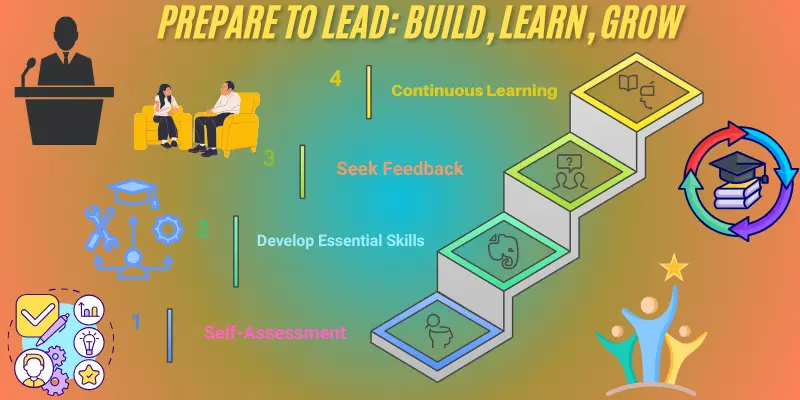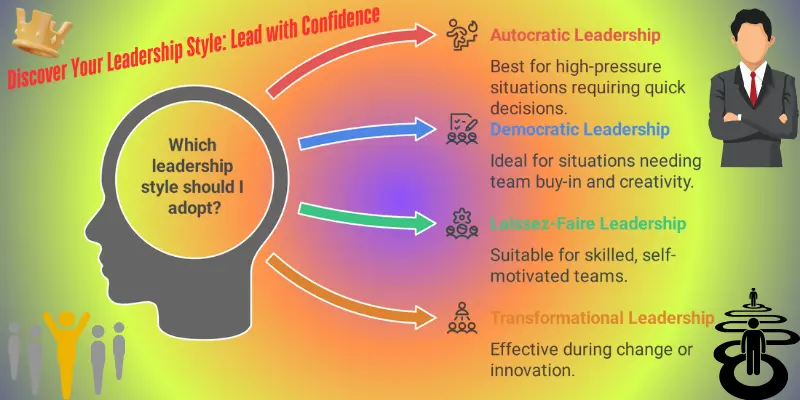From Colleague to Leader: How to Transition into a Leadership Role Successfully
Published: 28/03/2025
Ever been promoted to a leadership role and immediately thought, “Wait, how am I supposed to lead the same people I’ve been working alongside?”
It’s a common feeling. In fact, research from the Center for Creative Leadership shows that 60% of new leaders fail within their first 18 months due to the inability to adapt to their new role (Source: Center for Creative Leadership). That statistic might make you wonder: “Am I really ready for this?”
If you’re struggling with how to manage the transition from colleague to leader, you’re definitely not alone.
Moving from being part of the team to being the one in charge isn’t just a title change—it’s a complete shift in mindset and responsibilities. And it’s normal to feel uncertain about how to lead effectively, especially when you’re navigating relationships with former peers.
In this post, we’ll break down the steps you can take to make this transition smoother, from developing essential leadership skills to building stronger relationships with your team.
By the end, you’ll have the tools you need to step into your new role with confidence and avoid the mistakes that often lead to early failure.
Feeling unsure about how to take the first step? Keep reading to uncover the strategies that will help you thrive in your new leadership role. Let’s dive in!
1. Acknowledge the Shift
Recognize your move from peer to leader. Discuss the change openly with your team to set the right tone and prevent misunderstandings.
2. Set Clear Boundaries
Define roles, responsibilities, and expectations early to build respect and alignment.
3. Prioritize Growth and Collaboration
Focus on training, mentorship, and open communication to support your team’s success and your own development.
From Team Member to Team Leader: Embracing the Change
Moving from being a colleague to a leader isn’t just about a new title or responsibilities—it’s a shift in how you think, act, and interact with others.
The transition can feel like a major leap because you’re no longer just responsible for your own work, but for guiding and supporting a team to achieve collective goals. Here’s a closer look at what this transition really involves:
- New Responsibilities: As a leader, you’ll focus more on setting goals, making strategic decisions, and managing team dynamics rather than simply completing individual tasks.
- Mindset Shift: Your role goes from being a contributor to a motivator, coach, and decision-maker. You’ll be balancing short-term needs with long-term vision.
- Influence Over Tasks: Instead of focusing solely on “getting things done,” your success depends on how well you can empower others to do the same. This means a shift from personal performance to team performance.
- Building Relationships: Leadership is less about authority and more about creating trust and developing connections with your team and other leaders in the organization.
Understanding these key shifts will help you navigate this change and set yourself up for success.
It’s about thinking beyond yourself and stepping into a role that’s about empowering and supporting others to reach their potential.
Getting Ready to Lead: How to Prepare for Your Leadership Role
Before stepping into a leadership role, it’s important to take a step back and assess where you stand. Preparation is key to making a smooth transition.
By reflecting on your strengths and areas for growth, you can approach your new role with confidence and a clear strategy. Here’s how to get started:where you may need improvement.

Self-Assessment:
Take some time to reflect on your current skills. Identify your strengths and areas where you may need improvement.
Ask yourself:
What leadership skills do I already have? What do I need to develop?
Essential Skills:
Focus on building critical skills for success in leadership roles, such as:
- Communication: Clear, honest, and empathetic communication is essential for guiding your team.
- Decision-making: Learn how to make tough decisions confidently, considering both immediate needs and long-term impact.
- Emotional Intelligence: Recognize your emotions and those of others to foster a positive team culture.
Seeking Feedback:
Get input from colleagues, mentors, or previous leaders on areas you can improve. This will help you avoid blind spots.
Continuous Learning:
Leadership is a journey of growth. Take advantage of training, books, and mentorship to keep developing.
Taking the time to prepare for the role—both mentally and skill-wise—will help you hit the ground running when the leadership opportunity arrives.
Leaders who prioritize continuous learning are more likely to adapt to changes and drive innovation. According to a report by Deloitte, lifelong learning is essential for leaders to stay relevant in today’s fast-paced world.
“Leadership and learning are indispensable to each other”John F. Kennedy
From Colleague to Trusted Leader: How to Build Strong, Lasting Relationships
As you step into a leadership role, one of the most important things you’ll need to focus on is building strong, trusting relationships—both with your team and with other leaders.
These relationships will be the foundation for your success. Here’s how to approach it:
With Your Team
Establishing trust is key. Take the time to get to know your team members on a personal level, beyond just their work responsibilities.
- Spend one-on-one time: Check in with each person to understand their goals, challenges, and motivations.
- Be approachable: Let your team know you’re there to support them, not just manage them.
- Provide feedback: Regular, constructive feedback helps build mutual respect and keeps everyone on track.
With Other Leaders
Networking within the organization is just as important. Building relationships with fellow leaders can provide support, guidance, and open up new opportunities.
- Collaborate and learn: By working with other leaders, you can share insights and strategies for overcoming challenges.
- Seek mentorship: Experienced leaders can offer valuable advice and help you navigate tough decisions.
Remember, strong relationships don’t happen overnight. They require ongoing effort and authenticity. But once you’ve built that trust, you’ll have a solid foundation to lead and grow.
Tackling Leadership Challenges with Confidence
Transitioning into leadership comes with its fair share of challenges. As you move from being a colleague to a leader, you’ll face situations that test your skills, patience, and decision-making. The key is knowing how to tackle these challenges head-on. Here’s a look at some common obstacles and how to navigate them:
Managing Former Peers
One of the toughest challenges is managing people you once worked alongside. There may be some awkwardness or resentment.
- Set clear boundaries: Be transparent about your role and expectations.
- Earn respect: Show your team that you value their input and treat them with respect, even though your dynamic has changed.
Handling Conflicts
Conflicts will arise within any team, and as a leader, it’s your job to manage them effectively.
- Stay neutral: Listen to all sides before making a decision.
- Address issues quickly: Don’t let problems fester. Address them before they escalate.
- Encourage open communication: Foster a culture where team members feel safe to voice concerns.
“The greatest leader is not necessarily the one who does the greatest things. He is the one that gets the people to do the greatest things.”Ronald Reagan
Balancing Authority and Approachability
It can be difficult to balance being a leader while still maintaining good relationships with your team.
Be consistent: Consistency in your actions and decisions builds trust.
Stay approachable: Leadership doesn’t mean being distant. Make sure your team knows you’re there to support them.
Imposter Syndrome
Many new leaders feel like they’re not ready for the role. This self-doubt can be paralyzing.
- Seek mentorship: Don’t hesitate to reach out to experienced leaders for guidance.
- Acknowledge your achievements: Recognize the skills and experiences that got you here and remind yourself of your strengths.
Navigating these challenges may take time, but with the right strategies, you’ll be able to handle them confidently and grow into your leadership role.
Crafting Your Unique Leadership Identity: Stand Out as a Leader
Your leadership style is like your personal fingerprint—it’s what sets you apart and makes you effective in guiding others. When you understand your unique approach, you can:
- Build trust and credibility with your team.
- Make decisions that feel authentic and aligned with your values.
- Adapt your style to different situations without losing your core identity.
- Inspire others by leading in a way that feels genuine and relatable.
What Are the Main Leadership Styles?
Here’s a quick breakdown of the most common leadership styles and when they work best:

- Autocratic Leadership:
- What It Is: You make decisions independently, with little input from your team.
- When It Works: In high-pressure situations where quick decisions are needed (e.g., during a crisis or tight deadline).
- Example: A firefighter leading a team during an emergency.
- Democratic Leadership:
- What It Is: You involve your team in decision-making and value their input.
- When It Works: When you need buy-in from your team or when creativity and collaboration are key (e.g., brainstorming sessions or long-term projects).
- Example: A project manager gathering team feedback before finalizing a plan.
- Laissez-Faire Leadership:
- What It Is: You give your team a lot of autonomy and trust them to manage their own tasks.
- When It Works: With highly skilled, self-motivated teams who don’t need much oversight (e.g., experienced professionals or creative teams).
- Example: A software development team working on independent modules.
- Transformational Leadership:
- What It Is: You inspire and motivate your team to achieve more than they thought possible.
- When It Works: When you’re leading a team through change or innovation (e.g., launching a new product or entering a new market).
- Example: A CEO rallying their company to embrace a new vision.
- Servant Leadership:
- What It Is: You prioritize the needs of your team and focus on helping them grow.
- When It Works: In environments where team development and morale are critical (e.g., non-profits or team-building initiatives).
- Example: A team lead who regularly checks in on their team’s well-being and career goals.
How to Identify Your Leadership Style
Not sure which style suits you? Here’s a simple way to figure it out:
- Reflect on Past Experiences:
- Think about times when you’ve led a project or team. What felt natural to you? Did you prefer making decisions alone, or did you involve others?
- Ask for Feedback:
- Talk to colleagues, mentors, or even former teammates. Ask them how they’d describe your leadership approach.
- Take a Leadership Style Quiz:
- There are free online tools (like those from MindTools or Indeed) that can help you identify your dominant style.
How to Adapt Your Style to Different Situations
The best leaders aren’t tied to one style—they adapt based on the situation and their team’s needs. Here’s how to do it:
- Assess the Situation:
- Ask yourself: Is this a crisis? Does the team need direction or autonomy? Are we working on a creative project or a routine task?
- Know Your Team:
- Are they experienced and self-motivated, or do they need more guidance? Adjust your style to match their level of skill and confidence.
- Be Flexible:
- If your usual style isn’t working, don’t be afraid to switch things up. For example, if you’re naturally democratic but your team is struggling with decision-making, try a more directive approach.
- Communicate Clearly:
- Let your team know why you’re changing your approach. For example, “I know I usually ask for your input, but we’re on a tight deadline, so I’ll make the call this time.”
Why Flexibility Matters
No single leadership style works for every situation. Being able to adapt shows emotional intelligence and earns your team’s trust. Plus, it helps you handle challenges more effectively—whether it’s a tight deadline, a conflict, or a team that’s struggling to stay motivated.
Setting Expectations Early
Transitioning from peer to leader can feel awkward, but setting clear boundaries early is key to maintaining respect and professionalism. Here’s why it matters:
- Avoids Confusion: Clear boundaries help your team understand your new role and responsibilities.
- Builds Trust: Being upfront about changes shows you’re fair and transparent.
- Prevents Favoritism: Treating everyone equally ensures no one feels left out or unfairly treated.
- Sets the Tone: It establishes a professional dynamic that supports your leadership.
Start by having honest conversations with your former peers. Let them know your role has changed, but your respect for them hasn’t.
How to Establish Team Goals and Performance Expectations from Day One
Setting clear goals and expectations early helps your team stay focused and aligned. Here’s how to do it:
- Be Specific: Clearly define what success looks like for the team and each individual.
- Make It Collaborative: Involve your team in setting goals so they feel invested.
- Set Measurable Targets: Use numbers or deadlines to track progress (e.g., “Increase sales by 10% in Q1”).
- Communicate Regularly: Check in often to provide feedback and adjust goals as needed.
- Lead by Example: Show your commitment to the goals through your actions.
When everyone knows what’s expected, it’s easier to work together and achieve results.
Creating a “First 90-Day Leadership Plan” to Structure the Transition
The first 90 days are critical for establishing yourself as a leader. A clear plan keeps you on track and builds confidence. Here’s a simple framework:
- Month 1: Listen and Learn
- Meet with team members individually to understand their strengths and challenges.
- Observe team dynamics and identify areas for improvement.
- Month 2: Set Priorities
- Define 2-3 key goals for the team based on what you’ve learned.
- Communicate these priorities clearly and explain why they matter.
- Month 3: Take Action
- Start implementing changes or initiatives to address team goals.
- Celebrate small wins to build momentum and morale.
This plan gives you a roadmap to navigate the transition smoothly while showing your team you’re organized and focused.
Confidence in Leadership: How to Inspire and Empower Your Team
Confidence is one of the most important qualities a leader can have, but it’s important to distinguish it from arrogance.
As a new leader, you might struggle with self-doubt, but with the right mindset and actions, you can build genuine confidence that will inspire your team. Here’s how to lead with confidence:
Confidence vs. Arrogance
It’s easy to confuse confidence with arrogance, but the difference is key.
- Confidence inspires trust—when you believe in yourself and your decisions, others are more likely to follow.
- Arrogance alienates people—it can come across as dismissive or unapproachable, which can damage relationships with your team.
Building Confidence
Confidence doesn’t happen overnight, but there are steps you can take to strengthen it:
Celebrate small wins: Acknowledge your progress and successes, no matter how small, to build momentum.
- Be decisive: Even if you’re unsure, make decisions and stand by them. Indecision can erode your confidence and confuse your team.
- Own your mistakes: Mistakes happen. When they do, own up to them, learn from them, and move forward. This shows humility and strengthens trust.
Fostering a Positive Atmosphere
Your confidence can help create an environment where your team feels secure and motivated to do their best work.
- Acknowledge your team’s contributions: Regularly recognize the efforts of your team members to build their confidence too.
- Show vulnerability: Being honest about challenges can make you more relatable and encourage your team to trust you.
- Create a Safe Space: Encourage team members to share ideas, feedback, and concerns without fear of judgment.
- Regular Check-ins: Schedule regular one-on-one and team meetings to discuss progress and address any issues.
- Team Bonding: Organize team-building activities, both in and out of the office, to strengthen relationships
Leading with confidence isn’t about being perfect; it’s about believing in your ability to grow and inspiring your team to believe in theirs.
Your Leadership Journey Starts Now: Key Takeaways and Next Steps
Transitioning from a colleague to a leader is a significant milestone that shapes your career and the success of your team. Embracing this change with the right mindset and strategies can set you up for long-term leadership success.
- Transitioning into a leadership role requires a shift in mindset, moving from individual contributor to team guide and decision-maker.
- Self-assessment is crucial—know your strengths and areas for growth before stepping into leadership.
- Building strong relationships with your team and other leaders lays the foundation for success.
- Common challenges, like managing former peers or handling conflicts, can be navigated with clear boundaries and open communication.
- Confidence in leadership comes from consistent action, self-reflection, and a willingness to learn from both successes and mistakes.
Avoid the mistake of thinking leadership is all about authority—it’s more about supporting, guiding, and empowering your team. Also, don’t rush the process of building trust. Give it time and consistency to grow.
Leadership isn’t a destination; it’s a journey of growth and continuous learning. Step into your role with confidence, but remember, great leaders are always evolving. You’ve got this—now take the next step in your leadership journey!
Your Leadership Questions Answered: Clearing Up Common Doubts
Set clear boundaries and expectations while maintaining open and honest communication. Show appreciation for their support and be mindful of any changes in dynamics, ensuring you treat everyone fairly and respectfully.
Common styles include autocratic, democratic, and laissez-faire. The best style depends on the situation and team dynamics. It’s often beneficial to be flexible and adapt your style to meet the needs of your team and organization.
Absolutely. While some people may have natural tendencies toward leadership, leadership skills can be developed over time. With dedication, practice, and continuous learning, anyone can become an effective leader.
Recognize and celebrate team achievements, provide constructive feedback, and create opportunities for professional growth. Show genuine interest in your team members’ development and well-being, and lead by example.
Common mistakes include micromanaging, neglecting team feedback, and failing to delegate. Avoid these by trusting your team, actively listening to their input, and distributing tasks based on strengths and expertise.
Prioritize self-care by setting aside time for relaxation and hobbies. Delegate tasks when possible and don’t hesitate to seek support from mentors or colleagues. Remember, taking care of yourself is crucial for effective leadership.
Practice active listening and clear, concise communication in your daily interactions. For decision-making, practice analyzing situations, considering multiple perspectives, and making informed choices. Consider enrolling in workshops or online courses to hone these skills.

- Be Respectful
- Stay Relevant
- Stay Positive
- True Feedback
- Encourage Discussion
- Avoid Spamming
- No Fake News
- Don't Copy-Paste
- No Personal Attacks

- Be Respectful
- Stay Relevant
- Stay Positive
- True Feedback
- Encourage Discussion
- Avoid Spamming
- No Fake News
- Don't Copy-Paste
- No Personal Attacks





